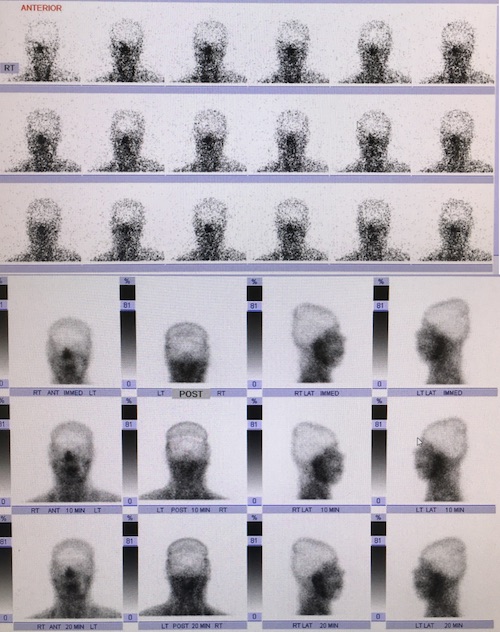Surgical Critical Care: Brain Death
Brain Death
Prognosis
- Two Factors are 100% Specific for Poor Outcome in Absence of Cofounding Factors:
- Absent or Extensor Motor Response on Day #3
- Absent Pupillary or Corneal Reflexes on Day #3
Diagnosis
- Criteria:
- No Spontaneous Respirations
- No Response to Pain
- No Cranial Nerve Reflexes
- *Can Still Have Spinal Cord/Deep Tendon Reflexes
- Excludes Dx:
- Hypothermia (Core Temperature < 34-36 C)
- Hypotension (Systolic Blood Pressure < 90-100 mmHg)
- Significant Metabolic Derangements (Electrolytes, Acid-Base or Endocrine)
- Depressant Drugs
- Definitive Testing (If All Criteria Met):
- Preferred Test: Positive Apnea Test
- If Hemodynamically Unstable & Unable to Tolerate Time Off Ventilator:
- Four-Vessel Cerebral Angiogram (Generally the Gold Standard but More Invasive)
- MRA/CTA
- Nuclear Cerebral Scintigraphy
- Less Preferred: EEG or Transcranial Doppler
Cranial Nerve Reflexes
- Pupillary Light Reflex – Light Shown into the Eye
- Normal: Prompts Pupil Constriction
- Abnormal: Pupil Does Not Constrict
- Corneal Reflex – Cornea Touched with Cotton Swab or Saline
- Normal: Prompts Blinking
- Abnormal: Does Not Blink
- Gag Reflex – Touching the Posterior Pharyngeal Wall
- Normal: Prompts Palate Elevation
- Abnormal: No Palate Elevation
- Cough Reflex – Tracheal Suctioning
- Normal: Prompts Coughing
- Abnormal: Does Not Cough
- Oculocephalic (Doll’s Eyes) Reflex – With Eyes Held Open the Head is Briskly Turned Side-to-Side & Held at the End of the Turn
- Normal: Eyes Rotate to the Opposite Side of Head Rotation (Continue to Look Forward)
- Abnormal: Eyes Do Not Rotate
- *Must First Ensure that the C-Spine is Clear
- Oculovestibular (Cold Caloric) Reflex – With Head Elevated at 30 Degrees, 200 cc of Ice Water is Instilled into the External Ear Canal
- Normal: Nystagmus with Eye Deviation to the Tested Ear
- Abnormal: No Nystagmus Seen
Apnea Test
- Test:
- Ensure CO2 Normal (35-45 mmHg) Before Starting
- Preoxygenate with 100% O2
- Disconnect the Ventilator for 10 Minutes
- Continue to Deliver O2
- Results:
- Positive: PaCO2 > 60 mmHg or Increase by > 20 mmHg
- Negative: Spontaneous Breathing, SBP < 90 or Desaturation of PaO2 < 85
- Restart Vent
Children (≤ 18 Years)
- Brain Death Pronunciation Requires Two Separate Examinations Preformed by Two Separate Physicians with an Observation Period In Between
- Age ≤ 30 Days: 24 Hours Between
- Age > 30 Days:12 Hours Between
Physiologic Derangements After Brain Death
- Cardiac Dysrhythmias – From Increased Catecholamines & Myocardial Dysfunction
- Circulatory Collapse with Peripheral Vasodilation
- Hypovolemia
- Hypothermia
- Coagulopathy
- Metabolic Acidosis
- Hypernatremia with Diabetes Insipidus – From Hypothalamic Dysfunction
- Hyperglycemia
- Hypothyroidism

Brain Death on Nuclear Cerebral Scintigraphy